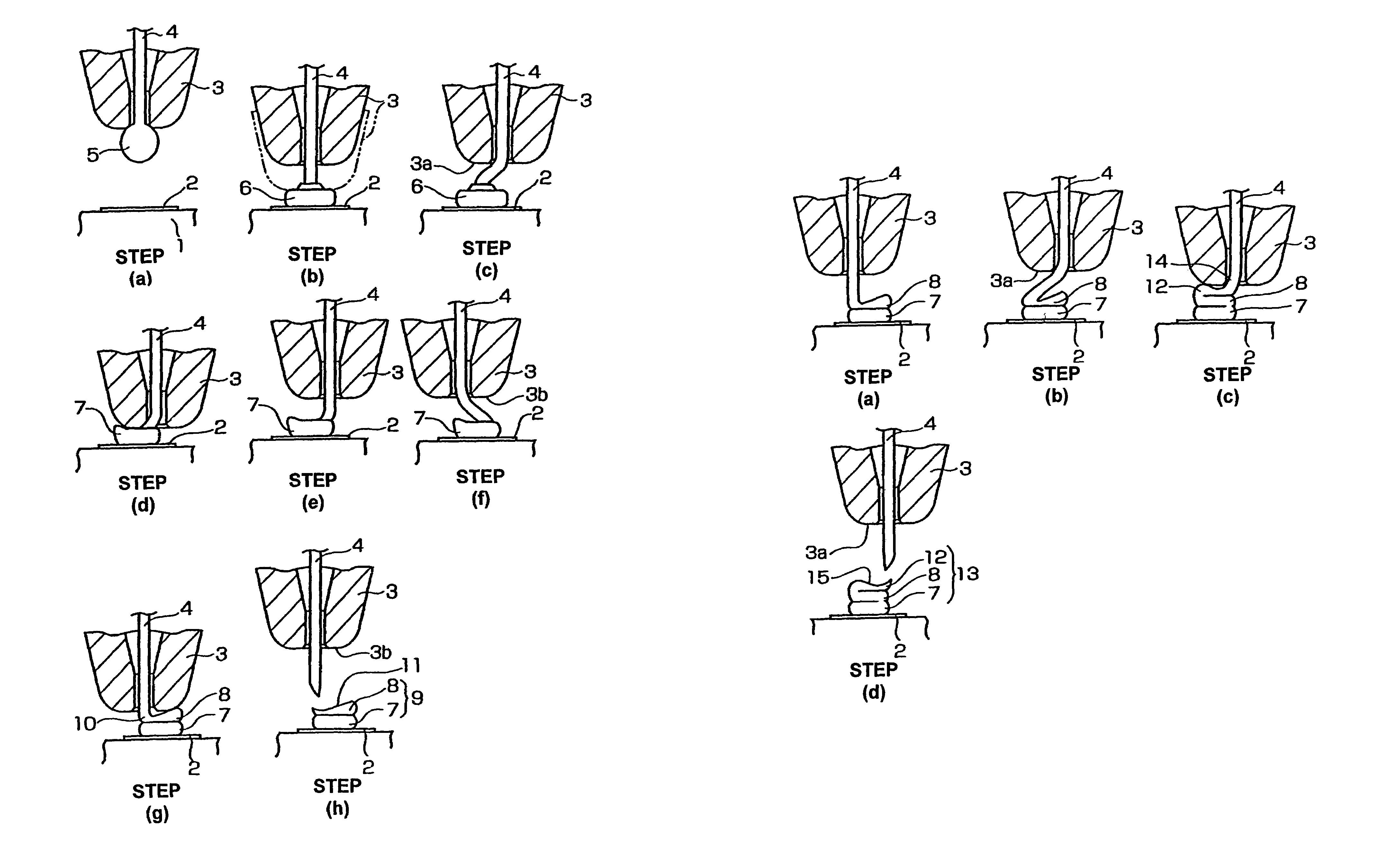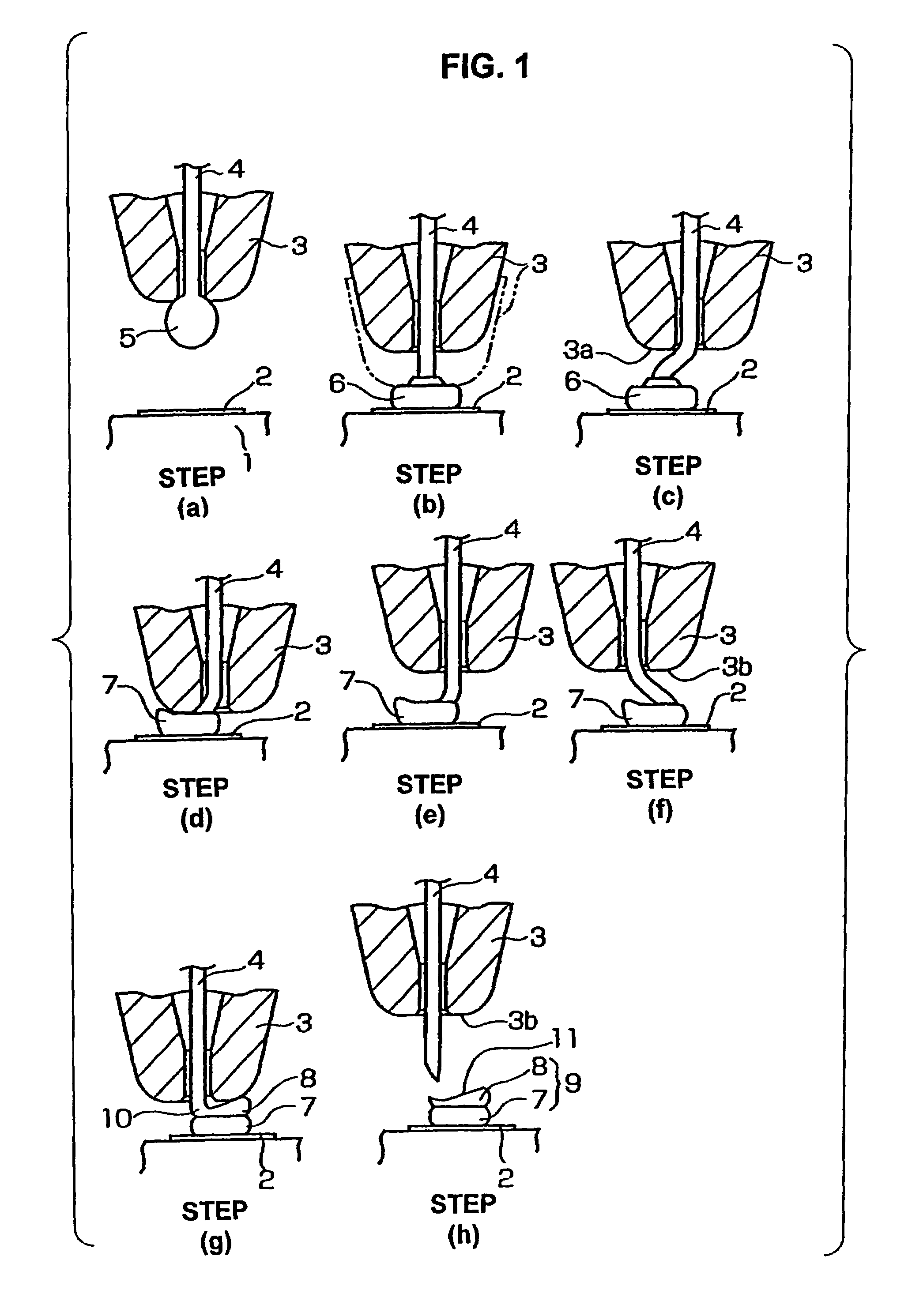Bump formation method and wire bonding method
a technology of wire bonding and bubbles, which is applied in the direction of soldering apparatus, manufacturing tools,auxillary welding devices, etc., can solve problems such as poor productivity, and achieve the effect of superior in terms of productivity and uniform height and shap
- Summary
- Abstract
- Description
- Claims
- Application Information
AI Technical Summary
Benefits of technology
Problems solved by technology
Method used
Image
Examples
first embodiment
[0023]the present invention will be described with reference to FIG. 1.
[0024]In FIG. 1, the reference numeral 1 indicates a semiconductor element, and 2 indicates an electrode pad 2 which is formed on the surface of the semiconductor element 1.
[0025]As seen from step (a) in FIG. 1, a ball 5 is formed by a spark discharge, etc. on the tip end of a wire 4 that passes through a capillary 3, in a state in which a damper (not shown) is closed.
[0026]Next, in step (b), the damper (not shown) is opened, the capillary 3 is lowered as indicated by the two-dot chain line, and the ball 5 is joined to the surface of the electrode pad 2 by ultrasonic vibration, so that a press-bonded ball 6 is formed (or the ball 5 becomes the press-bonded ball 6).
[0027]Next, the capillary 3 is raised as indicated by the solid line in sep (b); and then in step (c), the capillary 3 is moved in the horizontal direction (to the right) so that a flat portion 3a on the lower end of the capillary 3 is positioned to fac...
second embodiment
[0032]FIG. 2 shows the present invention.
[0033]This embodiment shows a case in which a three-stage bump 13 is formed (as shown in the illustration for the step (d) in FIG. 2) by forming a third bump 12 which has an inclined wedge 15 formed by the transfer of the external shape of the lower end surface 3a of the capillary 3 on top of the second bump 8 formed in the steps shown in FIG. 1. The step (a) in FIG. 2 is the one that follows the step (g) in FIG. 1.
[0034]Following the step (g) in FIG. 1, the capillary 3 is raised in step (a) of FIG. 2 with the damper (not shown) kept opened.
[0035]In step (b) of FIG. 2, the capillary 3 is moved in the horizontal direction (to the right) so that the flat portion 3a of the capillary 3 is positioned to face the second bump 8.
[0036]Then, in step (c), the capillary 3 is lowered, the wire 4 is bent and pressed while being completely superimposed on the surface of the second bump 8, and ultrasonic waves are applied so that a cut-out 14 is formed. As ...
PUM
| Property | Measurement | Unit |
|---|---|---|
| height | aaaaa | aaaaa |
| shape | aaaaa | aaaaa |
| internal diameter | aaaaa | aaaaa |
Abstract
Description
Claims
Application Information
 Login to View More
Login to View More - R&D
- Intellectual Property
- Life Sciences
- Materials
- Tech Scout
- Unparalleled Data Quality
- Higher Quality Content
- 60% Fewer Hallucinations
Browse by: Latest US Patents, China's latest patents, Technical Efficacy Thesaurus, Application Domain, Technology Topic, Popular Technical Reports.
© 2025 PatSnap. All rights reserved.Legal|Privacy policy|Modern Slavery Act Transparency Statement|Sitemap|About US| Contact US: help@patsnap.com



